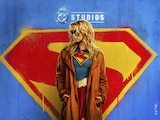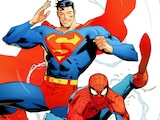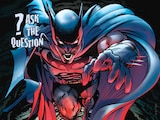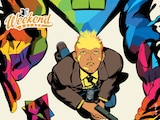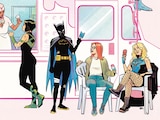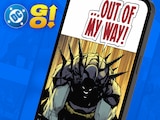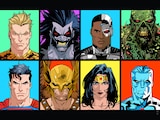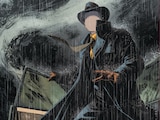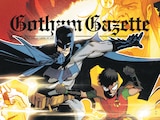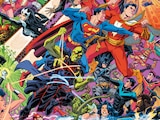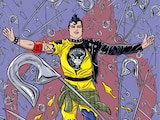“The Ties That Bind,” an episode from my favorite animated series Justice League Unlimited, opens like this: a woman watches an entire train drop onto a poor, doomed escape artist. It pulverizes him. The woman rushes over and, with amazing strength, flings scraps of the wreckage aside like gift wrap. But the escape artist is already behind her, smug and completely unharmed. This superwoman embraces him, but because she is also extremely annoyed, she scolds him, picking him clean off his feet.
When I watched this unfold for the first time as a teenager, my mind was successfully boggled. I had questions. Namely: “Who is that woman? And, oh my god…is that tiny man her husband?”
This was my introduction to Big Barda and the escape artist Mister Miracle, heroes of Jack Kirby’s epic Fourth World. Barda was brawny, brash, and had a huge bleeding heart—and yes, that Houdini in the red, green, and yellow was her husband, Scott Free. The episode trotted out other incredible Fourth World staples including Granny Goodness and Kalibak, Boom Tubes and Mother Boxes, and even the super-prison, the X-Pit. Needless to say, this animated adventure left a lasting impact on me. Because over the last two years, I’ve had the pleasure of writing and illustrating Barda, the newest DC graphic novel for Young Adults.

I’ve been a fan of DC Comics since I was a kid. For evidence, check out my middle school planners where I forwent writing down Ms. Baun’s math assignments and instead adorned the pages with color pencil drawings of Wally West and Kyler Rayner. If you do some digging on DeviantArt circa 2004, you might find some comics about Wonder Girl, Impulse, and the rest of Young Justice. (My parents had no idea I was sharing artwork online! Thanks, mom and dad!) And I have no clue when Blue Beetle and Booster Gold took hold of my impressionable young mind, but I was drawing fanart of those two chuckleheads before I knew how to drive.
But Boom Tubes? Mother Boxes? Even though I’ve been reading DC Comics for decades, I was a newcomer to this pocket of the DC Universe. When I first pitched my idea of a Barda-focused graphic novel to my editor, Jim Chadwick, it was to answer questions that I first had while watching shows like Justice League Unlimited and reading comics like Justice League International. (Which, of course, was a series created by J.M. DeMatteis, Keith Giffen, and Kevin Maguire. Was it any surprise that J.M. DeMatteis penned “The Ties That Bind,” the very episode that got me into Barda in the first place?) I knew that Barda was big, strong, and fun—but how did she and Scott meet? What about the duo made them irresistibly electric? How can Barda be so violent yet so loving? And how in the name of Darkseid did she go from being a villain to being a hero?

Barda is a graphic novel for teens…but it is also kinda my thesis submission for a master’s degree in Jack Kirby studies from DC Comics University. For two years, I dove headfirst into Jack Kirby’s Fourth World, and I didn’t just read the comics, oh no. To ensure that Barda was developed with precision, I read and watched Jack Kirby interviews, searching for the thematic DNA of New Genesis and Apokolips. I learned about Kirby’s obsession with mythology, religion, and morality, and his fascination with the Free Love movement. And of course, I read my textbooks—New Gods (1971), Mister Miracle (1971), and The Forever People (1971)—to understand the rules of Barda’s world and the cosmic stakes that went with them. Call me a purist, but my focus was narrow. I only deviated to read Walt Simonson’s brilliant solo series Orion—a virtuoso performance. But for the most part, I wanted the story straight from the King himself.
One unexpected side-effect of my research? I entered a simple investigator and left a fervent acolyte of the cult of Kirby. Because of characters like Funky Flashman, I now have strong opinions on Stan Lee. When people express discomfort with Kirby’s art style, I chide them—it’s obviously an acquired taste for true intellectuals. And whenever anyone maligns Orion, first hero of the Fourth World…um, I now go a little nuts. (Orion is a noble warrior! He is NOT a jerk!! Read the original texts, people! Thank you!! Bye!!)

Reading the Fourth World is one thing—attempting to recreate it and introduce others to it is another. Writing Big Barda was a particular challenge. When I create female protagonists, they’re usually not…well, badasses. They’re like me—anxious black nerds. And I find that when most folks try to create “strong” female characters, they often end up with “boring” female characters. But thankfully for us, Big Barda was created by Jack Kirby, who knew that dynamic characters are always walking contradictions. Writing Barda meant showing a character who is faithful to Darkseid, but attracted to the rebel Scott Free. Writing Barda was showing a character who wants to emulate Granny Goodness, but cannot relish in cruelty. Writing Barda was showing a soldier in a dark war, but a warrior with a noble heart. In every chapter of Barda, she needed to be pulled in two directions.
Then there was drawing Barda, an entirely different challenge. I come from the illustrious world of boy’s love webcomics—hang with me here—and we do not have a ton of violent cosmic showdowns in my part of town. We mostly have cute kisses. Barda needed to show our eponymous character as not just a lover, but a fighter. I mean, look. In Big Barda’s first appearance in Mister Miracle #4, she attempts to bludgeon Oberon with her mega-rod. In subsequent Fourth World appearances, she also throws a spaceship at another spaceship, picks up a one-ton civil war cannon, and attempts to strangle her future husband. So while Barda has some cute kisses (spoilers: she falls in love with her future husband), it needed to pack a punch. Barda is full of open, expressive emotions, a color story that is linked to Barda’s internal world, and a cartoony style inspired from growing up with the DC Animated Universe. I put my all into a particular splash page, doing my best bombastic Kirby wallop. You’ll know it when you see it.

But comic lovers know that comics are more than just writing and drawing. There’s something else, a certain spark—a crackle, even—that happens in between the panels. Barda exists in a world of the brightest good and the darkest evil. Characters like Big Barda are iconic because they are so remarkably brave in the face of hopelessness. Barda believes against all odds. Barda is Jack Kirby’s Fourth World writ small—a case study in how nature vs. nurture is truly irrelevant. All that matters is that those who align themselves to good will always triumph. That needed to be in every page of this graphic novel. Well, that, and a few splashes of Kirby Krackle.
I’ve always been a student of DC Comics, but becoming a creator was like stepping into the Boom Tube and going on my own epic journey. (You gotta remember—the middle school girl in me would hate herself if she got her first DC comic wrong!) My very first creations were JLA fancomics drawn on school notebooks with colored pencils. Now, as the first black woman to write as well as illustrate a graphic novel for DC, it was an honor to tackle the stories of Jack Kirby, the comics pioneer to end all comics pioneers. I trust that because he loved storytelling, and because I love storytelling, I ended up with something right. Something good. Something I would’ve adored when I was a kid. If this stuff is old news to you, then I hope you enjoy this reintroduction to Big Barda. But if this is all brand new, I hope Barda inspires you to fall headfirst into the realm of New Genesis and Apokolips—and into the rest of the DC Comics Universe.
Ngozi Ukazu is a DC Comics artist, New York Times-bestselling graphic novelist, and the creator of comics like Check, Please!, BUNT!, and the forthcoming graphic novel FLIP. She graduated from Yale University with a degree in Computing in the Arts, and since 2020 her cartoons have appeared in The New Yorker.

